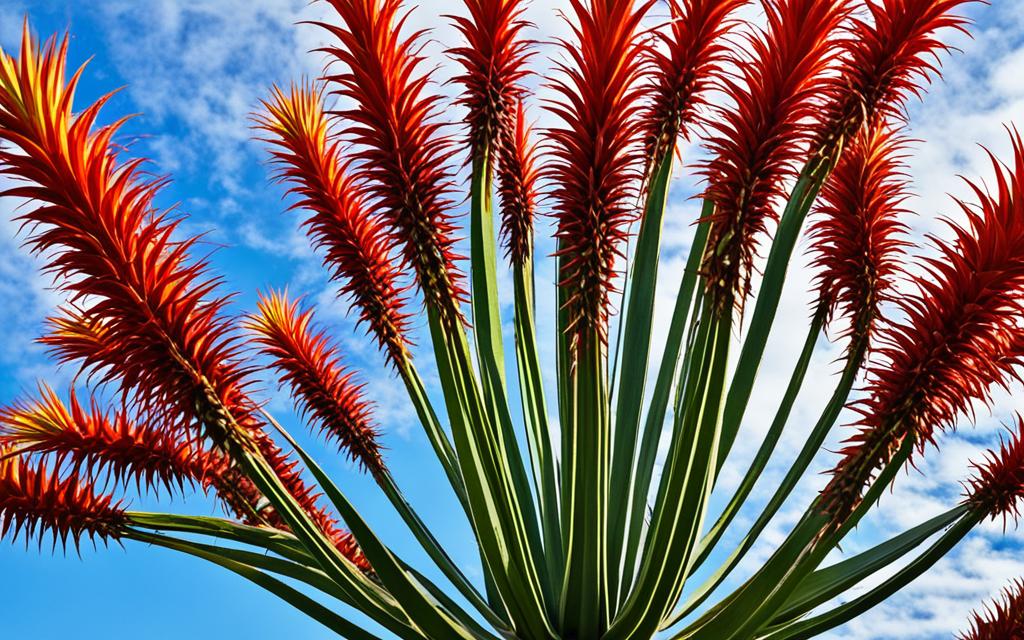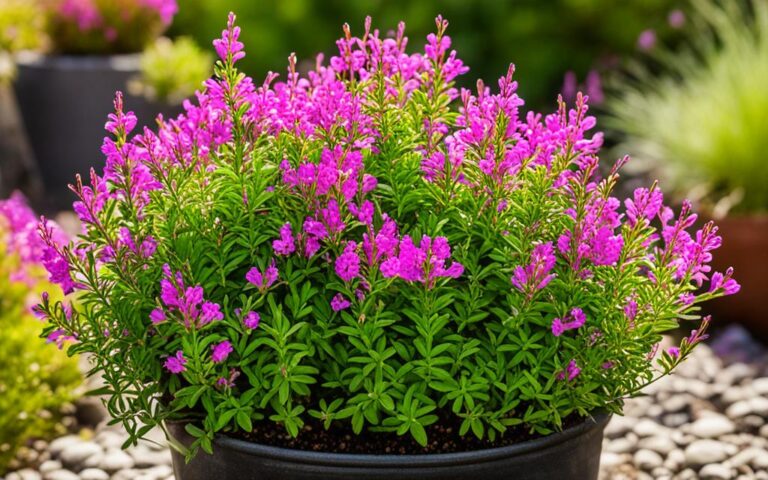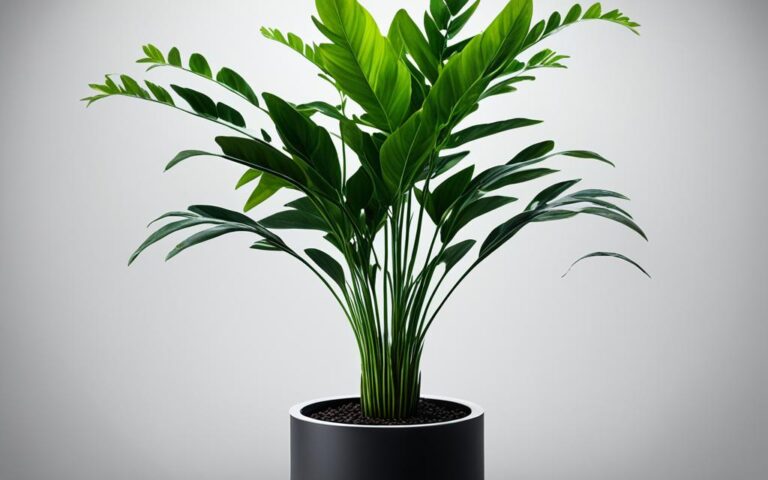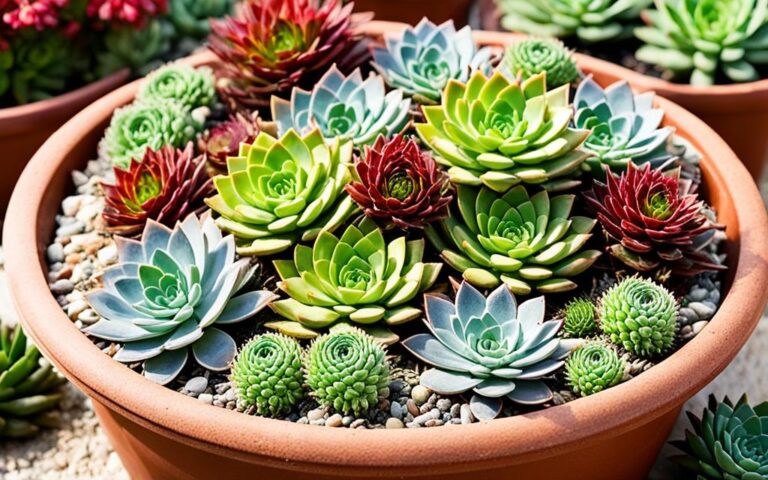Century Plant Bloom: A Rare and Spectacular Event
Picture a tall flower display, almost as high as a three-story building, coming from a small succulent. This is the amazing story of the century plant, also known as the Agave americana. It’s a natural wonder that captures the heart. The name “century plant” suggests it blooms every century, but it actually blooms every 10 to 25 years. This makes its bloom a true rarity.
The century plant’s life cycle is special. It blooms once and then dies. This makes its bloom even more rare. But when it blooms, it’s a big event. People come from far to see it.
Key Takeaways
- Century plants typically bloom once every 10 to 25 years, making their appearance a rare and infrequent event.
- The century plant’s unique life cycle and monocarpic nature contribute to the rarity of its blooming.
- When the century plant does bloom, it does so in a grand and awe-inspiring display, often attracting visitors to witness this natural wonder.
- The century plant’s bloom period can last anywhere from days to a few weeks, offering a brief but unforgettable display.
- The flower stalk of the century plant can grow to be an impressive 25-30 feet tall, adding to the plant’s dramatic appearance.
What is a Century Plant?
The century plant, known as Agave americana, is a type of succulent that comes from Mexico and the southern U.S. It doesn’t bloom every 100 years as its name suggests. Instead, it flowers every 10 to 25 years, which is quite rare and beautiful. This plant blooms only once before it dies, making it special.
Misleading Name and Rarity
The name “century plant” is a bit confusing, as it doesn’t bloom every century. Actually, it flowers every 10 to 30 years, depending on the environment. This makes its bloom a big event, attracting many people whenever it happens.
Unique Life Cycle and Monocarpic Nature
- Century plants take 8 to 30 years to flower.
- The Agave Americana, or century plant, blooms every 10 to 30 years in deserts.
- This plant blooms only once before it dies.
- After blooming, it drops seeds that spread the plant.
- During the bloom, new plants, called “pups,” grow from its base, keeping the species alive.
Anatomy and Features of the Century Plant
The century plant, also known as the Agave, is a fascinating succulent from the southwestern United States and Mexico. It has striking looks and amazing adaptations. This plant shows the beauty of nature.
Description of Leaves, Stems, and Flowers
The century plant has big, thick leaves that can grow up to 5 feet tall. When it’s ready to bloom, it gets a tall stalk over 30 feet high with greenish-yellow flowers. These flowers form clusters and show off the plant’s growth power.
Special Characteristics and Adaptations
- This plant has special traits to live in dry places, like storing water in its leaves.
- Agave plants take 10 to 30 years to grow up, storing lots of sugar and starch for their big flowers.
- Most Agave plants live a single life cycle, dying after they bloom and fruit. But they can make new plants through offsets, lasting for centuries.
- Agave plants spread from Utah to Mexico, mostly in dry areas. About 40 out of 150 species in North America live in the Sonoran Desert.
These special traits and adaptations make the century plant amazing and worth learning more about.
The Blooming Process of the Century Plant
The century plant, also known as the Agave, blooms in a way that’s both amazing and captivating. These plants, part of the Agave genus, are famous for their tall and beautiful flowers. Most century plants live for 25 to 30 years. They bloom impressively when they are between 10 to 30 years old.
Signs of an Impending Bloom
In winter, the first signs of a bloom appear. A single stalk, like an asparagus, comes out from the leaves’ center. This stalk grows very fast, up to 5-6 inches a day. It can get over 20 feet tall.
Growth Rate and Towering Height
As the bloom gets closer, the plant changes a lot. It grows a stalk with greenish-yellow flowers. These flowers are huge and greenish-yellow, making the plant look even more amazing. The stalk can get as tall as 35 feet, which is incredible.
The century plant’s bloom shows its unique life cycle and special nature. It dedicates all its energy to one big bloom before it dies. This event is rare and amazing, attracting people from everywhere to see it.
Spectacle of the Century Plant Bloom
The blooming of the century plant is a sight to see. It attracts visitors from everywhere, eager to see nature’s floral display. The tall stalk with its delicate flowers makes a century plant bloom spectacle that amazes everyone.
An American Agave (century plant) at The Greenery Garden Center is over 17 feet tall, as of late May. It’s about 20 years old, planted 15-16 years ago. People thought it took 100 years to bloom, but it’s actually 10-25 years.
The flower stalk can be 15 to 30 feet tall and 6 inches wide. This makes the towering botanical event truly impressive. The blooming lasts 3 to 4 months, with each flower lasting a month. This means a long, beautiful display.
In a Texas neighborhood, a century plant is about to bloom for the first and last time. It’s caught the eye of the locals. A century plant over two stories high in a Houston backyard has also drawn attention. People stop to admire its size, as it’s a native plant of Mexico and the southern US.
The century plant bloom spectacle is truly remarkable and unforgettable. These rare events show the beauty of nature and the century plant’s lasting beauty.
Ideal Growing Conditions for the Century Plant
The century plant, known as Agave americana, loves the dry lands it comes from. It needs lots of sunlight, warm temperatures, and can handle low humidity. To grow well, gardeners must give it the right mix of light, temperature, and moisture.
Light, Temperature, and Humidity Requirements
Century plants love being in the full sun. They do best with 6 hours of direct sunlight each day. If they get less sun, they might grow slower and bloom less.
They like temperatures between 50 to 90 degrees Fahrenheit. They can even handle -5 degrees Celsius. When it gets cold, you can bring them inside in big pots.
These plants don’t mind humidity that’s low. But, they don’t like too much moisture, which can cause root rot.
Soil Composition and Watering Needs
Century plants need soil that drains well, like sandy or rocky soil. The soil should be neutral to slightly alkaline pH. Stay away from clay soils because they can hold too much water.
When watering, wait until the soil is dry. These plants store water in their leaves for dry times. Too much water is bad for them.
By giving your century plants the best light, temperature, humidity, and soil, they’ll do great. They might even show off their beautiful blooms.
Century Plant Bloom
Common Species and Varieties
The Agave americana, also known as the century plant, is famous for its blooms. Another variety, the Night Blooming Cereus, is known for its beautiful, night-blooming flowers. These flowers are fragrant and only open for one night.
The Agave parryi is a smaller, more compact type of century plant. It’s popular for gardens and landscaping. It takes 8 to 30 years to flower, and its flower stalk can grow over 30 feet tall.
The Agave americana can spread wide by producing many “suckers.” Each plant flowers once in its life, usually after 10 to 30 years. It can grow up to 12 feet wide, with leaves up to 6 feet long and 10 inches wide.
The Agave attenuata, or spineless century plant, is another unique choice for gardens. It can bloom several times a year, with flowers appearing about 10 years after planting. This plant grows 2 to 3 feet tall and 3 to 6 feet wide.
Whether you like the tall Agave americana, the fragrant Night Blooming Cereus, or the smaller Agave parryi and Agave attenuata, the century plant family has many beautiful blooms. These plants are sure to impress gardeners and nature lovers.
Propagation and Care of the Century Plant
Century plants, also known as Agave, are easy to spread through different methods. This lets you grow more plants or share them with friends. These plants live a long time and grow well with the right care.
Propagation Techniques
There are several ways to grow more century plants. You can use offsets, seeds, or cuttings. Offsets are the quickest way, taking 1 to 2 years to grow, while seeds take 3 to 5 years. The right temperature, between 65-75°F (18-24°C), is key for growing these plants.
- Offsets: Take pups or offsets from the main plant and put them in soil that drains well.
- Seeds: Plant seeds in trays or containers and keep them moist and warm until they grow.
- Cuttings: Cut stems, let them heal, then plant them in soil that drains well.
Pruning and Training Techniques
Pruning and training help shape century plants. Cutting off dead or damaged leaves keeps the plant looking good and stops rot or disease. Training the plant can make it look amazing, adding privacy, blocking wind, or adding texture to your garden.
Pest and Disease Management
Century plants are tough but can get pests and diseases if not cared for. Spotting and fixing problems like root rot from too much or too little water is important. Knowing how to care for these plants and watching for problems helps them stay healthy for a long time.
| Propagation Method | Time to Maturity | Advantages |
|---|---|---|
| Offsets | 1-2 years | Faster growth, cost-effective expansion |
| Seeds | 3-5 years | Genetic diversity, potential for new cultivars |
| Cuttings | Varies | Clonal replication of desired characteristics |
Cultural Significance and Uses
The century plant, or Agave americana, has a deep cultural and practical value for indigenous communities. It’s not just a pretty plant. It’s a key part of many traditions and ways of life.
Nectar as a Natural Sweetener
Indigenous peoples have used the century plant’s sweet nectar for centuries. They see it as a natural sweetener, better than regular sugar. Its unique taste and health benefits make it a favorite in many dishes, old and new.
Production of Mezcal and Other Liquors
The century plant is also important in making traditional Mexican spirits. It’s a main ingredient in mezcal, a drink similar to tequila. Making mezcal involves roasting and fermenting the plant to get its unique smoky flavor.
But mezcal isn’t the only spirit made from this plant. It’s also used in other agave-based liquors. This shows how important the century plant is in traditional drinks and foods.
Witnessing the Rare Bloom
The stunning and rare bloom of the century plant attracts visitors from all over the world. It’s a natural wonder that people can’t miss. Longwood Gardens in Pennsylvania is a famous spot where this event has happened many times in the last 20 years.
Locations and Events Showcasing the Bloom
A memorable century plant bloom was at The Greenery Garden Center’s American Agave plant. A stalk over 17 feet tall came from a plant that was about 20 years old. People thought it took 100 years to flower, but it’s actually 10-25 years.
The plant’s flower stalk can be 15 to 30 feet tall and about 6 inches wide. In a Raleigh neighborhood, a century plant took 25 years to grow to 20 feet tall. When it bloomed, the community came together to celebrate this rare event.
At Hamarikyu Gardens in Japan, the century plant is a big deal. Its flower stalk gets up to 6.5 meters tall and blooms for about a month. The last time it bloomed was in 2012, showing how rare these events are.
These century plant blooms are big events that bring people from everywhere. They’re a chance to see the beauty of nature up close. Whether it’s at Longwood Gardens or in local spots, seeing the century plant bloom is an experience you won’t forget.
Sustainable Practices and Conservation Efforts
The century plant bloom is rare and highly sought after. This makes conservation efforts and sustainable practices crucial for these plants’ future. Agave landscapes in Mexico are divided into landscapes of cultivation and conservation. Farmers balance crop production with protecting habitats.
Sustainable farming methods, like terracing, help in saving century plants. Terracing deepens soils, improves moisture retention, and decreases runoff and erosion risks. This method lets farmers grow century plants while keeping the environment safe.
Public education is key to saving century plants. Some agave species are considered rare or endangered due to overharvesting and habitat loss. We need more people to understand and support sustainable farming.
“Agave cultivation and terracing have merged as effective ways for Mexican farmers to manage agricultural slopes and conserve these iconic plants.”
By using sustainable methods and supporting conservation, we can keep the century plant’s bloom alive for future generations.
Benefits and Ecological Importance of the Century Plant
The century plant, or Agave, is more than just beautiful. It’s crucial to the ecosystems it lives in. With over 200 species, these plants have special traits that help arid environments stay healthy.
One big plus of the century plant is how it saves water in its leaves. This lets it survive in places with little rain. When it blooms, its tall stalks draw in bees, hummingbirds, and bats, helping pollinators.
Most century plants die after one bloom, which can happen every 25-30 years. This cycle is key to keeping ecosystems balanced. It feeds pollinators and boosts biodiversity.
Century plants have been important to people for a long time. Agave Americana, for example, has made ropes, mats, and the drink pulque. Its nectar is also used as a sweetener.
As we work to save the environment, the century plant shows nature’s strength. By valuing these plants, we can help protect them and the ecosystems they live in.
Conclusion
The century plant bloom is a sight that leaves everyone in awe. It takes 20 to 40 years to grow and blooms only once before it dies. This plant shows the beauty and complexity of nature.
Learning about and saving these plants lets future generations see their beauty. The tall flower stalks, the food for pollinators, and the plant’s traditional uses show its great importance.
As we say goodbye to the agave plants at the University of Colorado Boulder, we remember their impact. The century plant bloom is a wonder that we must keep alive. It’s key to keeping nature’s balance and our cultural heritage.






